“Nuchi gusui” literally means “the medicine of life.” This phrase is used for things healing both our mind and body, such as our mother’s love, delicious food, human kindness, and amazing scenery. And the latter is especially true for a very unique region called Okinawa. And before you read on, you may grab a pen and write down the following:
Bucket list diving destinations: Okinawa, Japan.
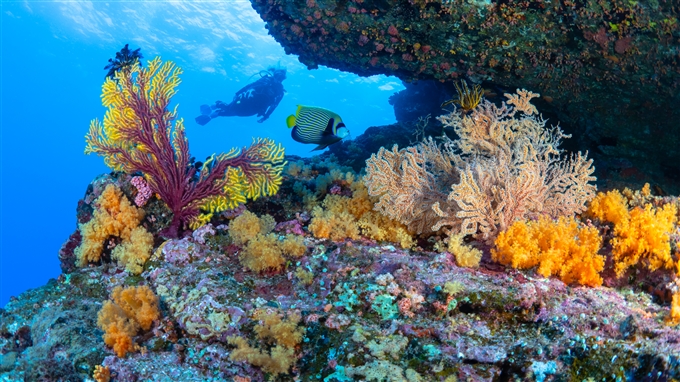 David Benz • E-M1 Mark II • M.Zuiko Digital ED 8mm f1.8 Fisheye PRO
David Benz • E-M1 Mark II • M.Zuiko Digital ED 8mm f1.8 Fisheye PRO
• PT-EP14 • PPO-EP02
The Okinawa Prefecture is the southernmost prefecture of Japan and an absolutely underestimated and sadly a largely unknown diver’s paradise, at least in the western world. Okinawa is a tropical destination attracting divers from all over the world with crystal clear waters, a visibility of up to 40 meters, beautiful reefs, dreamlike beaches and a stunning diversity of all sorts of small and big fish.
The warm Japanese current and the relatively stable climate literally allow corals to thrive. It is said that far over 200 species out of the world’s 800 species of corals inhabit the waters around Okinawa. So, the diving experience you can get here is as good as it gets for a tropical sea paradise. Still, it is highly depending on the exact region you visit and – the timing.
The Okinawa Islands and their highlights
The Okinawa main island offers a variety of good dive spots in the northern, middle and southern areas of the island. Most dive spots are located on the western side of the main island and provide divers with countless possibilities for shore diving and snorkeling. Cuttlefish and spotted eagle rays are only two of the possible species you can come across here.
Kume Island, west of the main island, mainly captivates tourists with endless sandy beaches and snorkeling options. Hatenohama Beach, for example, is a an approximately seven-kilometer-long sand bar surrounded by water just east of the island. Besides the whale sharks (May – August) and the humpback whales (November-March) it is one of the most famous attractions on this island.
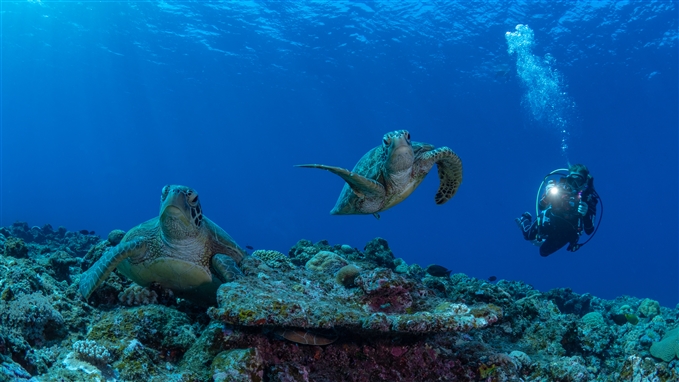
David Benz • E-M1 Mark II • M.Zuiko Digital ED 8mm f1.8 Fisheye PRO
• PT-EP14 • PPO-EP02
The Kerama Island group, about 40 kilometers from the main island, is one of the most popular parts of Okinawa. It is known for its exceptional water quality and consists of 22 inhabited and uninhabited islands. Some coral reefs in this area are simply unparalleled. So, it comes as no surprise that Kerama Islands Marine Park with its rocky reefs was designated as a national park in 2014. Though the waters of the Keramas officially open to public swimming in mid-April, the average temperature of approximately 20°C even through the winter allows for you to enjoy this pristine area all year round. And if you’re lucky, you might even swim with one of the three sea turtle species that flourish here and spawn on the beaches of Zamami Island from May to August each year.
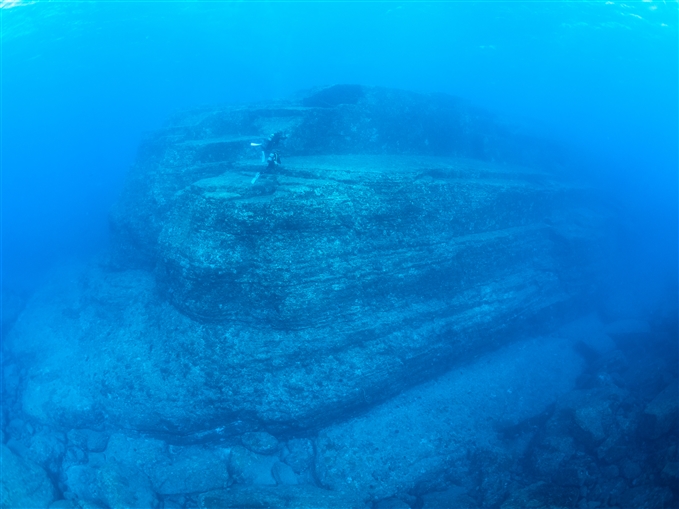 David Benz • E-M1 Mark II • M.Zuiko Digital ED 8mm f1.8 Fisheye PRO
David Benz • E-M1 Mark II • M.Zuiko Digital ED 8mm f1.8 Fisheye PRO
• PT-EP14 • PPO-EP02
Miyako Island, on the other side, is mostly appreciated by cave diving experts and fans of breathtaking vaults and caves that create the most picturesque underwater world. Arrow barracudas and dogtooth tuna are just two species you may find in this part of Okinawa.
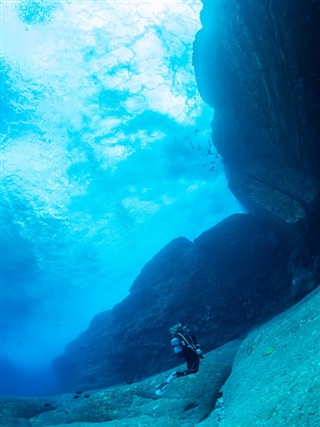 |
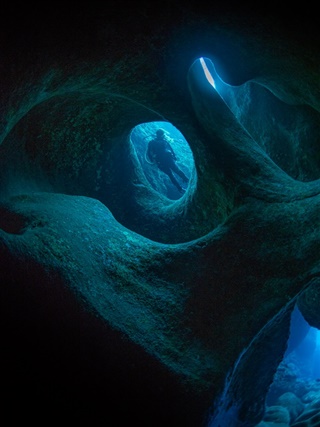 |
David Benz • E-M1 Mark II • M.Zuiko Digital ED 8mm f1.8 Fisheye PRO
• PT-EP14 • PPO-EP02
But that’s not enough: West of Miyako, Manta fans will find their absolute paradise. The Yaeyama region is mostly famous for its island Ishigaki where mantas can be found between April and November. But the other three islands of this region (Iriomote, Kuro and Hateruma) can also convince experts and beginners with beautiful corals and diverse dive sites.
 David Benz • E-M1 Mark II • M.Zuiko Digital ED 8mm f1.8 Fisheye PRO
David Benz • E-M1 Mark II • M.Zuiko Digital ED 8mm f1.8 Fisheye PRO
• PT-EP14 • PPO-EP02
And when the Manta seasons ends, the time for the hammerhead sharks begins. Huge shoals of up to 300 animals can be found at the outer sea of the Yaeyama region, but most of all they appear in the area around Yonaguni Island (also called the Japanese Galapagos), the southernmost part of Japan, only around 100 milometers from Taiwan. The big fish represent the area’s biggest attraction together with the mysterious Yonaguni monument. This submerged rock formation off the coast of Yonaguni is said to be man-made steps. Still, its existence is unresolved and there is debate about whether the site is completely natural, a natural site that has been modified, or a man-made artefact.
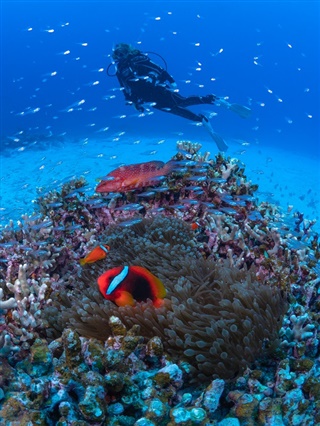 |
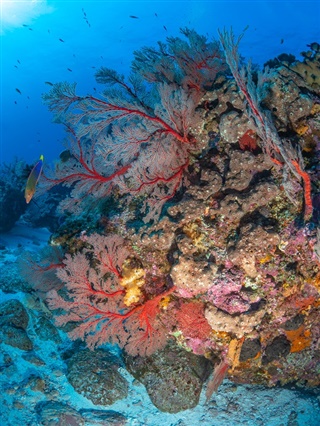 |
David Benz • E-M1 Mark II • M.Zuiko Digital ED 8mm f1.8 Fisheye PRO
• PT-EP14 • PPO-EP02
The island of the centenarians
There should no longer be any doubt that Okinawa has to be put on every diver’s bucket list. This secret jewel for divers offers so much and yet, we know so little about it. It is one of these places we cannot believe we have never heard of and one of the most vibrant sceneries there are for underwater photographers and divers of all sorts.
But also travel-wise in general, this Japanese insider’s tip can stun us with a mixture of a surprising and yet delicious cuisine, cultural sights and a very healthy nature. And this is also true for the inhabitants. Not for nothing, Okinawa is called the “island of the centenarians.” A combination of a mild climate, the beautiful ocean, rich earth and gentle people as well as the ingredients that grow on the island and the way they are cooked are a real medicine of life and the reason for happy and healthy people. Can you wish for more?
Our Olympus Visionaries Melanie and David Benz had the pleasure to give this miracle cure a try and convince themselves that Okinawa is indeed a real treat for divers of all kinds – and underwater photographers, of course. In their two-week journey, they discovered the most beautiful dive spots Okinawa has to offer. More inspiring images and their full trip report will follow soon in this blog.

Comments
Show more comments (3)